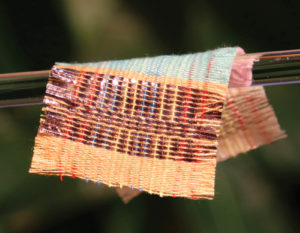
As more people want easy-to-use, take-along power sources for phones and other electronic equipment, smart fabrics that generate electricity are gaining interest. Typically, they produce energy from motion. But a team of researchers led by Zhong Lin Wang, a regents professor in the Georgia Tech School of Materials Science and Engineering in Atlanta, Ga., has developed a fabric that generates energy from two sources: sunshine and movement.
The fabric was produced using a commercial textile machine to weave together solar cells constructed from lightweight polymer fibers with fiber-based triboelectric nanogenerators. The nanogenerators generate a small amount of electrical power from mechanical motion like rotation, sliding or vibration. To produce electricity from sunlight, the researchers used photoanodes made in a wire-shaped fashion that could be woven together with other fibers.
According to Wang, the material is economical to produce and environmentally friendly, making manufacturing on a large scale realistic. The fabric, 320 micrometers thick and woven together with strands of wool, is flexible, breathable and lightweight. Potential uses include clothing, tents and other products.
 TEXTILES.ORG
TEXTILES.ORG


